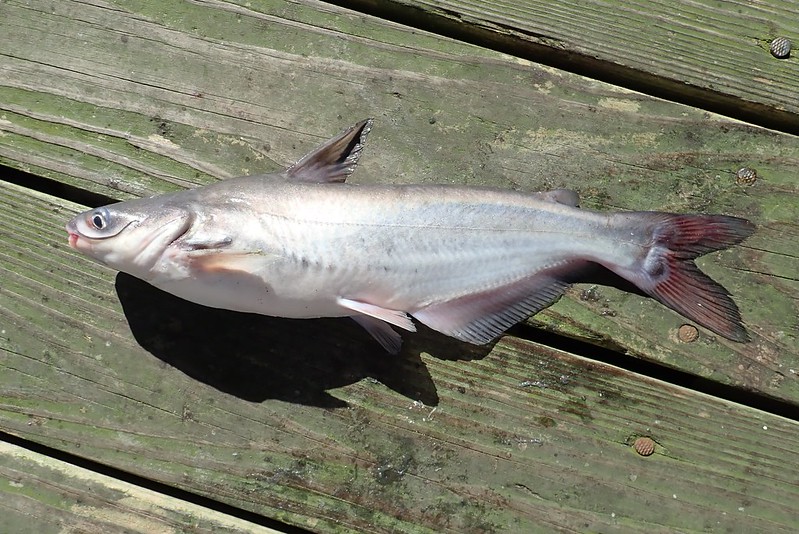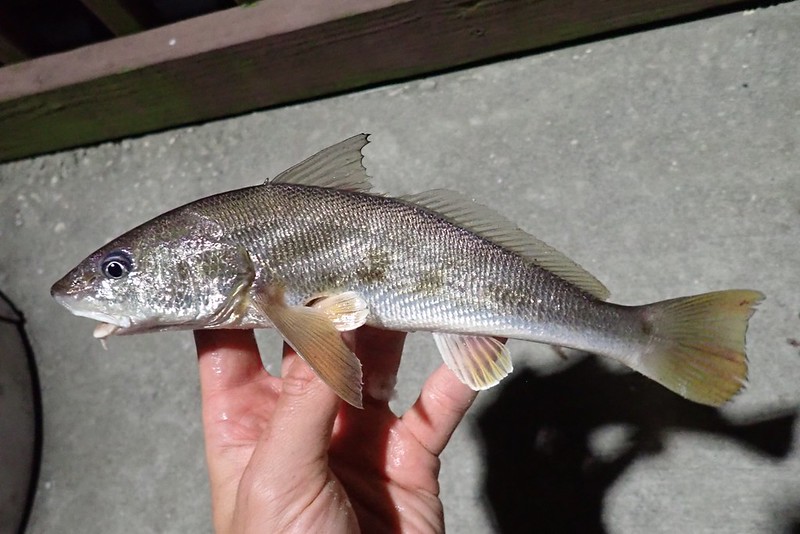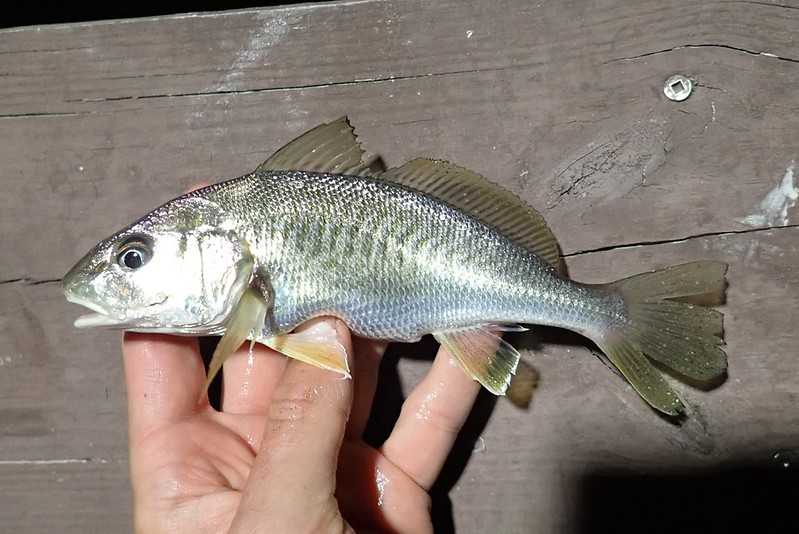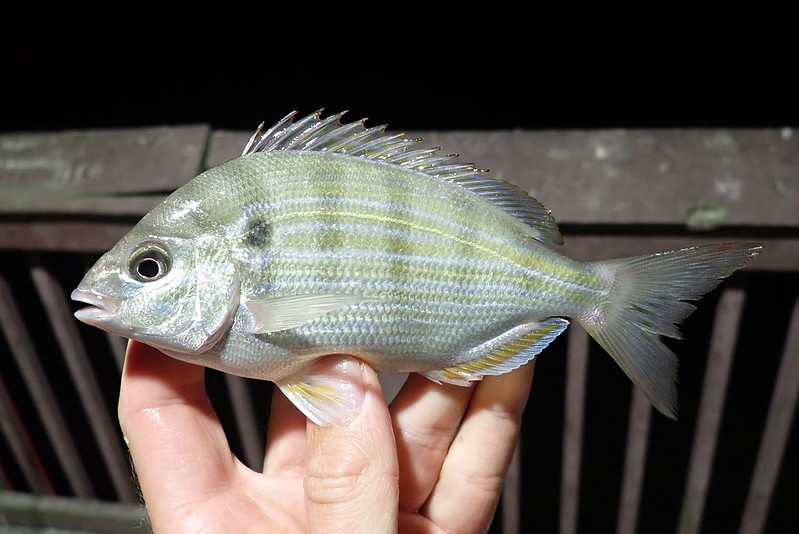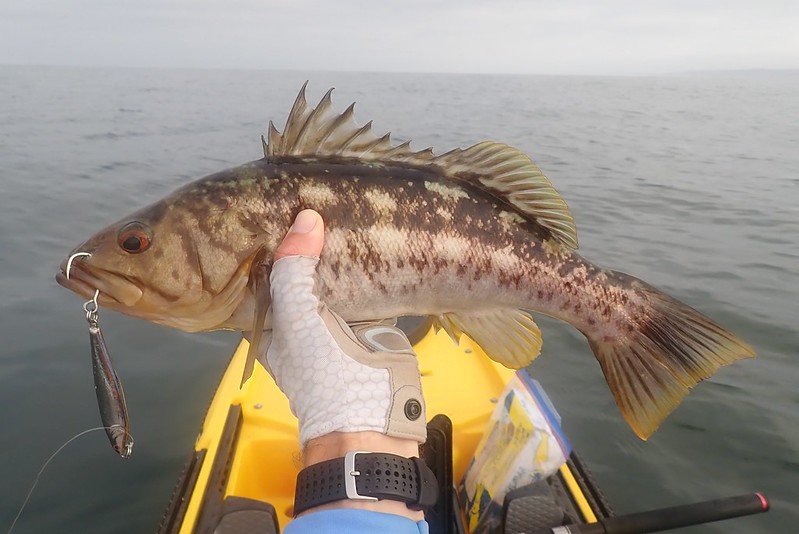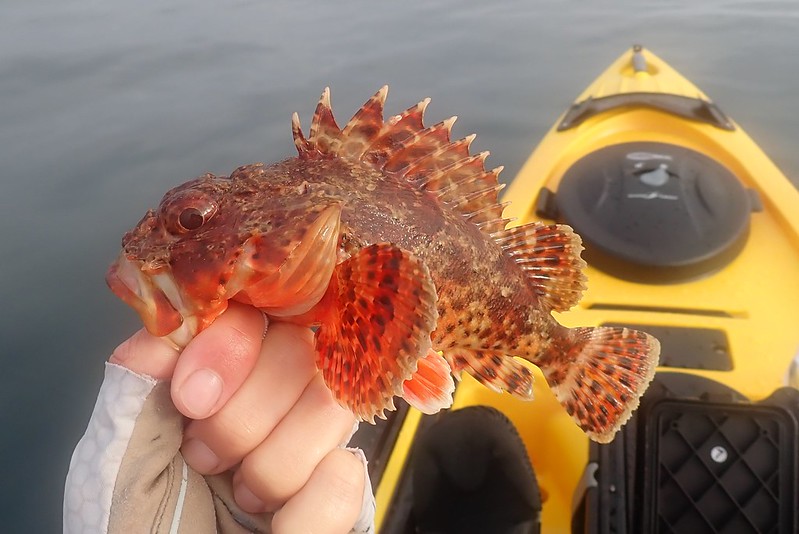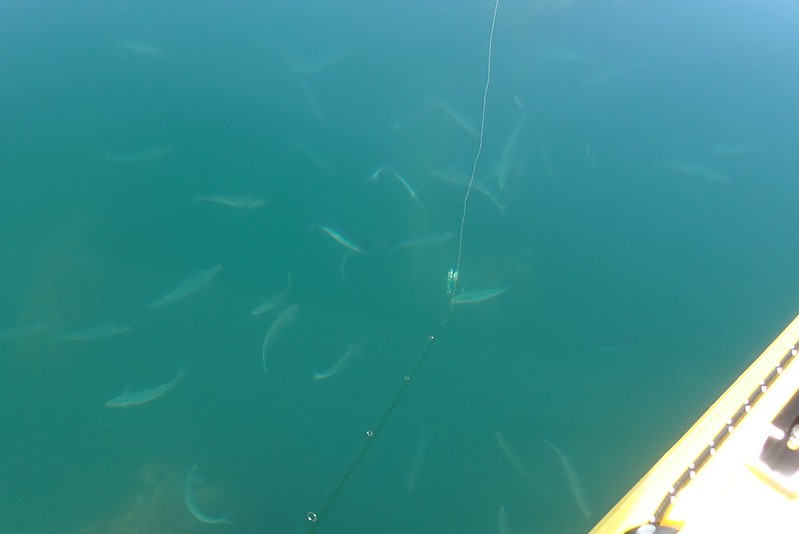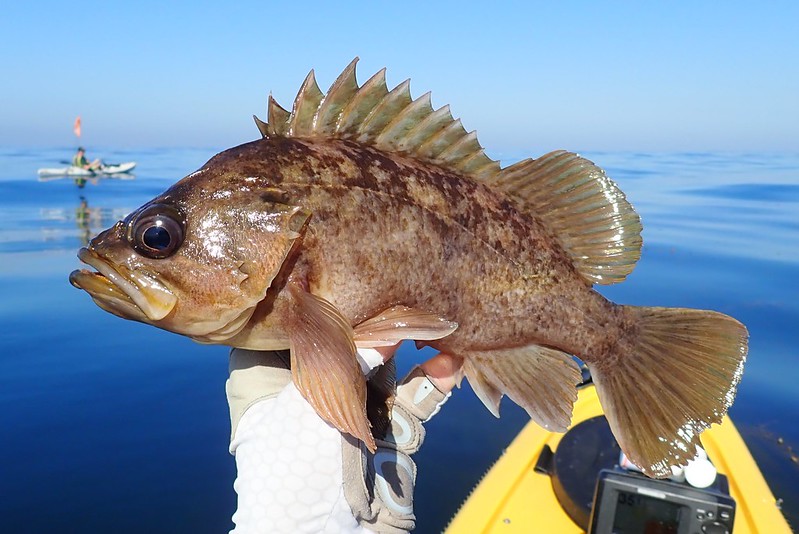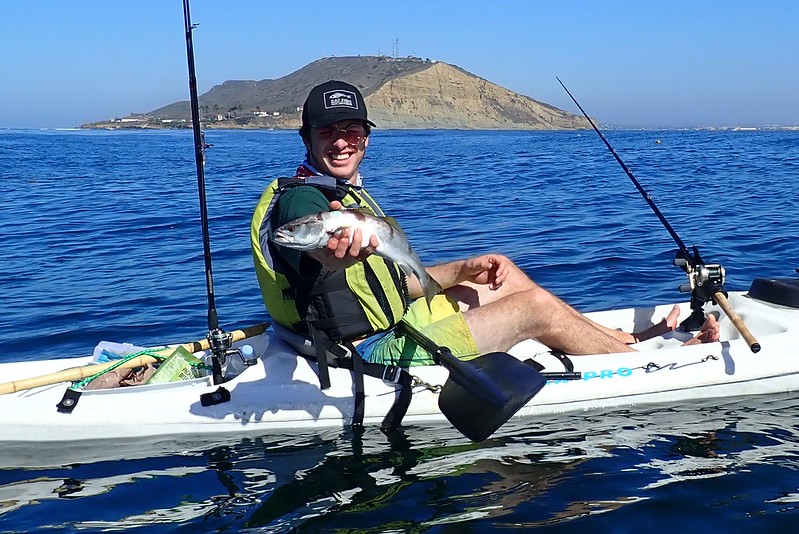Back in September I was in Louisiana for a conference, and I was able to fit in a little fishing on the side while I was there. The first night I drove across the Lake Pontchartrain Causeway to check out Sunset Point Fishing Pier in Mandeville, LA. It was hot and humid, and coming from San Diego the humidity was really a shock. There was a nice breeze though, and while it was probably a little windy for fishing, it made the humidity more bearable.
Lake Pontchartrain is a brackish estuary with salinity about half of pure seawater. I did my homework before the trip, and it looked like hardhead catfish and gafftopsail catfish are common catches. The latter would be a new species for me, so that was my primary target. I also needed some common fish like red drum, black drum, and a couple other croaker and shark and ray species so I was hopeful that I could add a few new ones to the list. I fished shrimp on two rods, one with a fish finder rig and the other with a high low rig. Hours went by, and I was only able to catch two fish, both of which were blue catfish. It was supposed to be mostly saltwater species at this pier, so what was going on?
Blue Catfish (Ictalurus furcatus)
I chatted with a few locals, and apparently the Army Corps of Engineers was releasing freshwater from the reservoir upstream to prevent flooding. It had rained a lot a week or two before I arrived, but I didn't realize it would still be having an affect on the fishing. I enjoyed the sunset and then packed up my gear to head back to the hotel. Originally I planned to fish a few hours into the night, but there was no point if it was only going to be freshwater species I'd already caught.
Fast forward to the end of the conference, and I had one last opportunity to catch some fish before I flew back to San Diego. I figured Lake Pontchartrain again would be wasting time, so I headed east to find pure saltwater. A quick Google search turned up the Garfield Ladner Pier in Waveland, MS, which was a pretty short drive despite being across the state line.
I've fished quite a few piers over the last decade, and surprisingly this was one of the best I've experienced. It had good lighting, benches, and roofed sections. I set up about half way to the end with the plan of fishing for a couple of hours and then moving down to the end to see if the species lineup changed. Switching to pure saltwater made a world of difference. The water around the pier was swarming with small sand seatrout. If you didn't get your bait down to the bottom quickly you'd hook one almost immediately.
Sand Seatrout (Cynoscion arenarius)
Bait on the bottom would sit for a little while longer, but before long a catfish would pick it up. Most of them were hardheads, a species I picked up last year in Tampa, but twice I hooked nice sized gafftopsail catfish only to have them shake off the hook as I was lifting them up to the pier. I didn't let it bother me too much, because I had all night and wouldn't leave until I caught one, but it still hurt seeing a new lifer fall back to the water before I could get it to hand.
Hardhead Catfish (Ariopsis felis)
Much less common than the seatrout and catfish were the croakers. I caught two species - southern kingcroaker and Atlantic croaker - and while neither was a new species, I was happy to finally have a photo of Atlantic croaker. I caught one back in 2012 from the Skyway Pier in Tampa, but it slipped out of my hand and went straight down a PVC drain hole to the water below before I could take a photo. It's not something I've been proud of. Now if I can just find a gulf kingcroaker, I'll have photos of all the fish on my lifelist!
Southern Kingcroaker (Menticirrhus americanus)
Atlantic Croaker (Micropogonias undulatus)
The night was getting late, so I moved down to the end of the pier. I figured my odds of getting a gafftopsail would be the same, and if it got really late I could always come back to where I hooked the two earlier. I set up one of the rods with shrimp for smaller fish and the other with cut bait on a large circle hook for small sharks, rays, or even a big drum.
Moving was a good choice, because it only took a few minutes to catch a gafftopsail. It was much smaller than the two earlier ones, but as they say, a fish in hand is worth a lot more than one kerplunking back into the water after shaking off your hook.
Gafftopsail Catfish (Bagre marinus) - new hook & line species #646
The cut bait had a few taps, probably from small catfish, but nothing big picked it up. I caught more of each of the species above, and the only addition was a pinfish. I won't ever say no to a species because I like having the content for blog posts, but I'm glad there weren't more pinfish out that night. Anyone who's fished a pier in Florida knows what I'm talking about!
Pinfish (Lagodon rhomboides)
I called it a night around midnight so I could get back to the hotel and catch some sleep before flying out in the morning. It took a lot of effort to catch one new species, but I was glad to get out of the city and see a part of the country that I wouldn't otherwise get to see. Hope you enjoyed the read!
Monday, September 30, 2019
Sunday, September 22, 2019
Taking the Ocean Kayak on the ocean
For my second trip in the new kayak I joined up with David, a member from the bigwatersedge message board. We met at La Jolla Shores and launched shortly after sunrise. The surf wasn't high, but I timed the sets wrong and took a wave to the chest. It wasn't a big deal, but it was a bit annoying to be soaked to start the day.
Our plan was to paddle past the marine reserve and fish outside the kelp beds in roughly 100 feet of water. I used a 2 oz iron tipped with squid, which is my standard bottom fishing method for that depth of water. I picked up my first fish right away, an ocean whitefish.
Ocean Whitefish (Caulolatilus princeps)
My next fish hit with a bigger thump and turned out to be a calico bass. It wasn't a huge one, but it wasn't a small fish either. It was looking to be a good day! The bites continued, and the species count kept going up. Sheephead were a surprising catch on the iron.
Kelp Bass (Paralabrax clathratus)
California Scorpionfish (Scorpaena guttata)
California Sheephead (Semicossyphus pulcher)
Kelp Rockfish (Sebastes atrovirens)
Not pictured is a big treefish that came off the hook as I was lifting it into the boat. Quick release! There was also a lot of bait being pushed to the surface, so we stopped jigging the bottom to see what was going on.
The bait looked to be small fish like anchovies or sardines, and the predators were mackerel that weren't all that much larger. Small jigs got hit by mackerel right away.
Pacific Chub Mackerel (Scomber japonicus)
After about five hours on the water our lower backs were feeling it, so we paddled back to the launch. I trolled a small Rapala as we went, and I caught one fish on it, an embarrassingly small calico bass. My first trolled fish from this kayak! They can only get bigger, haha.
Kelp Bass (Paralabrax clathratus)
Our route looked like a pretty typical La Jolla fishing session.
Miles: 6.76
Hours: 5:45
I was really happy with this session considering that I didn't have the fish finder installed yet. Seven species is pretty solid only using irons (ok fine, the squid was cheating a bit). La Jolla has a lot more diversity to explore though, from deeper water rockfish species to big predators like yellowtail and white seabass. Expect more reports in the future!
Our plan was to paddle past the marine reserve and fish outside the kelp beds in roughly 100 feet of water. I used a 2 oz iron tipped with squid, which is my standard bottom fishing method for that depth of water. I picked up my first fish right away, an ocean whitefish.
Ocean Whitefish (Caulolatilus princeps)
My next fish hit with a bigger thump and turned out to be a calico bass. It wasn't a huge one, but it wasn't a small fish either. It was looking to be a good day! The bites continued, and the species count kept going up. Sheephead were a surprising catch on the iron.
Kelp Bass (Paralabrax clathratus)
California Scorpionfish (Scorpaena guttata)
California Sheephead (Semicossyphus pulcher)
Kelp Rockfish (Sebastes atrovirens)
Not pictured is a big treefish that came off the hook as I was lifting it into the boat. Quick release! There was also a lot of bait being pushed to the surface, so we stopped jigging the bottom to see what was going on.
The bait looked to be small fish like anchovies or sardines, and the predators were mackerel that weren't all that much larger. Small jigs got hit by mackerel right away.
Pacific Chub Mackerel (Scomber japonicus)
After about five hours on the water our lower backs were feeling it, so we paddled back to the launch. I trolled a small Rapala as we went, and I caught one fish on it, an embarrassingly small calico bass. My first trolled fish from this kayak! They can only get bigger, haha.
Kelp Bass (Paralabrax clathratus)
Our route looked like a pretty typical La Jolla fishing session.
Miles: 6.76
Hours: 5:45
I was really happy with this session considering that I didn't have the fish finder installed yet. Seven species is pretty solid only using irons (ok fine, the squid was cheating a bit). La Jolla has a lot more diversity to explore though, from deeper water rockfish species to big predators like yellowtail and white seabass. Expect more reports in the future!
Sunday, September 15, 2019
Traded the Old Town for an Ocean Kayak
It's finally time to retire my Old Town sit-inside kayak and get a proper sit-on-top. The Old Town has been a great platform for fishing the bays, but at this point I've caught nearly all the common species that wander around San Diego and Mission Bay. I decided to stay with the same parent company (Johnson Outdoors) and get an Ocean Kayak Trident 13. With safety in mind I chose their most visible color, giant yellow banana.
The new boat's maiden voyage was in San Diego Bay, launching from Coronado Tidelands Park. My friend Tim joined me for a short bass fishing session. This was also the first time I recorded a kayak session on my Garmin watch, and afterward I took a screenshot of the route on the app.
Miles: 3.78
Hours: 3:21
I'm going to add a few of my early kayak sessions to this post since they don't have as many fish photos as I'd like for a typical blog post. My second outing was in La Jolla, but that trip has enough fish content to do a standalone post. For my third outing I paddled out of Mission Bay to look for bonito with my friend Emerson. The fish finder from my old kayak was installed at this point.
Emerson and I paddled south past the Ocean Beach Pier, but we didn't see any fish activity. There were a lot of dolphins in the area though, so they kept us entertained. I think in this photo Emerson was turning to watch a few of them jump behind us.
As we headed back north past the pier I finally got a hit on an Xrap Magnum 15. It wasn't a big bass, but it was still a fish! Someday this lure is going to get hit by a big yellowtail or mako.
Kelp Bass (Paralabrax clathratus)
With it being such a slow day we didn't stay out for very long. We jigged around the end of the north jetty for a few minutes, but I didn't see anything on the fish finder so we called it and headed back to our landing spot.
Miles: 6.40
Hours: 3:38
The next time I went out I met up with Kam, another local guy with a kayak. He has an old Ocean Kayak Scupper Pro, which has dimensions similar to my Trident. We launched from inside San Diego Bay and paddled out past the end of Point Loma to fish the kelp beds.
You can't fully appreciate how long Point Loma is until you paddle the length of it. We trolled lures as we went, but we didn't have any hits. The weather was great for us, but the fish weren't feeding.
Once we reached the kelp, about 5 miles from the launch, we jigged irons for bass, rockfish, or whatever else might hang out around heavy structure. Mostly though we caught mackerel.
Pacific Chub Mackerel (Scomber japonicus)
Along with the mackerel there were swarms of smelt (jacksmelt or topsmelt) that would nip at the iron but avoid getting hooked. Judging by how brazen they were, there must not have been any bigger predators around.
Finally I managed one non-mackerel fish from the bottom, a kelp rockfish. They're one of the more common species in less than 100 feet of water around San Diego.
Kelp Rockfish (Sebastes atrovirens)
I also had a decent kelp bass on, but it pulled me into the kelp and ended up coming off. The wind was picking up, so it was time for us to start heading back. Kam managed to get one last fish, his first white seabass! It was too small to keep, but it was still a really cool catch from the kayak.
White Seabass (Atractoscion nobilis)
The wind really picked up as we paddled back towards the launch. Kam and I were both pretty exhausted by the time we made it back. It was a good reminder to keep an eye on the wind and start heading in at any sign that it's beginning to pick up.
Miles: 10.66
Hours: 5:53
Ten miles was my longest paddle to date, so even though we didn't catch many fish, I still felt like it was training for longer days on the water.
The new boat's maiden voyage was in San Diego Bay, launching from Coronado Tidelands Park. My friend Tim joined me for a short bass fishing session. This was also the first time I recorded a kayak session on my Garmin watch, and afterward I took a screenshot of the route on the app.
Miles: 3.78
Hours: 3:21
I'm going to add a few of my early kayak sessions to this post since they don't have as many fish photos as I'd like for a typical blog post. My second outing was in La Jolla, but that trip has enough fish content to do a standalone post. For my third outing I paddled out of Mission Bay to look for bonito with my friend Emerson. The fish finder from my old kayak was installed at this point.
Emerson and I paddled south past the Ocean Beach Pier, but we didn't see any fish activity. There were a lot of dolphins in the area though, so they kept us entertained. I think in this photo Emerson was turning to watch a few of them jump behind us.
As we headed back north past the pier I finally got a hit on an Xrap Magnum 15. It wasn't a big bass, but it was still a fish! Someday this lure is going to get hit by a big yellowtail or mako.
Kelp Bass (Paralabrax clathratus)
With it being such a slow day we didn't stay out for very long. We jigged around the end of the north jetty for a few minutes, but I didn't see anything on the fish finder so we called it and headed back to our landing spot.
Miles: 6.40
Hours: 3:38
The next time I went out I met up with Kam, another local guy with a kayak. He has an old Ocean Kayak Scupper Pro, which has dimensions similar to my Trident. We launched from inside San Diego Bay and paddled out past the end of Point Loma to fish the kelp beds.
You can't fully appreciate how long Point Loma is until you paddle the length of it. We trolled lures as we went, but we didn't have any hits. The weather was great for us, but the fish weren't feeding.
Once we reached the kelp, about 5 miles from the launch, we jigged irons for bass, rockfish, or whatever else might hang out around heavy structure. Mostly though we caught mackerel.
Pacific Chub Mackerel (Scomber japonicus)
Along with the mackerel there were swarms of smelt (jacksmelt or topsmelt) that would nip at the iron but avoid getting hooked. Judging by how brazen they were, there must not have been any bigger predators around.
Finally I managed one non-mackerel fish from the bottom, a kelp rockfish. They're one of the more common species in less than 100 feet of water around San Diego.
Kelp Rockfish (Sebastes atrovirens)
I also had a decent kelp bass on, but it pulled me into the kelp and ended up coming off. The wind was picking up, so it was time for us to start heading back. Kam managed to get one last fish, his first white seabass! It was too small to keep, but it was still a really cool catch from the kayak.
White Seabass (Atractoscion nobilis)
The wind really picked up as we paddled back towards the launch. Kam and I were both pretty exhausted by the time we made it back. It was a good reminder to keep an eye on the wind and start heading in at any sign that it's beginning to pick up.
Miles: 10.66
Hours: 5:53
Ten miles was my longest paddle to date, so even though we didn't catch many fish, I still felt like it was training for longer days on the water.
Wednesday, September 11, 2019
Road trips 2019
Kern River, CA.
Sacramento Sucker (Catostomus occidentalis) - new hook & line species


Rainbow Trout (Oncorhynchus mykiss)

Rogers Spring, NV.

Common Molly (Poecilia sphenops)

Western Mosquitofish (Gambusia affinis)

Rio Grande Cichlid (Herichthys cyanoguttatus)




Armagosa River, CA.

Amargosa River Pupfish (Cyprinodon nevadensis amargosae)

Amargosa River Speckled Dace (Rhinichthys nevadensis nevadensis)

Western Mosquitofish (Gambusia affinis)

Sacramento Sucker (Catostomus occidentalis) - new hook & line species


Rainbow Trout (Oncorhynchus mykiss)

Rogers Spring, NV.

Common Molly (Poecilia sphenops)


Western Mosquitofish (Gambusia affinis)

Rio Grande Cichlid (Herichthys cyanoguttatus)




Armagosa River, CA.

Amargosa River Pupfish (Cyprinodon nevadensis amargosae)

Amargosa River Speckled Dace (Rhinichthys nevadensis nevadensis)

Western Mosquitofish (Gambusia affinis)


